Introduction
The concept of developing a Minimum Viable Product (MVP) has evolved beyond simply creating a product that is "good enough" for the market. The MVP approach focuses on deploying a product with core functionalities that engage the initial user base while gathering valuable feedback for future iterations. This article provides a comprehensive guide to developing an MVP, starting with understanding the concept and key objectives.
It then takes you through the step-by-step process of defining the problem, identifying core features, creating a product requirements document, organizing information architecture, building and testing the MVP, collecting and analyzing user feedback, iterating and improving the MVP, planning for iteration and growth, and finally scaling up and expanding the product. The article also highlights common pitfalls in MVP development and provides solutions to overcome them. By following these expert recommendations, you can effectively navigate the MVP development process and build a product that resonates with your target audience.
Understanding the Concept of MVP
The practice of developing a Minimum Viable Offering, or MVP, has evolved beyond simply creating a solution that is 'good enough' for the market. The MVP concept is focused on deploying a solution that encompasses the core functionalities necessary to engage the initial user base while also gathering valuable feedback for future iterations. This approach allows developers to validate their assumptions through real-world usage and refine the trajectory of their creation accordingly. By strategically emphasizing key characteristics, developers can deliver a creation that resonates with early adopters and establishes the groundwork for subsequent improvements.
Consider a scenario where a business requires an application to consolidate the accounting of multiple entities. The developer's task is to determine whether the item is a solution to a specific problem or a commodity that simplifies an existing process. This differentiation is crucial; the character of the item decides the tactical method to its advancement. In the case of a solution, the focus would be on addressing a particular problem faced by the businesses, whereas a commodity would aim to enhance convenience and efficiency.
A frequently disregarded yet crucial element of the MVP development procedure is the emotional attachment of the individual to the item. The idea of a Minimum Lovable Offering (MLO) has arisen as a reaction to the constraints of MVPs, promoting a solution that is not only feasible but also appealing to the individual from the beginning. This method focuses on developing something that ignites the enthusiasm of individuals, as opposed to one that simply fulfills the fundamental criteria.
The industry's viewpoint on MVPs has changed due to a common pitfall: the haste to launch a creation quickly and inexpensively, which can lead to a subpar offering. Delivering value to the consumers and standing out in the market is what makes a kick-ass half, not a half-assed whole. It's about creating something that's both efficient in development and effective in addressing user needs. A well-conceived minimum viable product (MVP) can serve as a strategic tool in the development lifecycle, steering clear of unnecessary features that don't align with customer desires and the offering's core purpose.
Key Objectives of an MVP
Developing a Minimum Viable Product (MVP) is a strategic venture that demands a clear understanding of its key objectives to ensure a focused and effective development process. These objectives are diverse and critical for a successful launch.
-
Validating the Product Idea: The core purpose of an MVP is to test the waters with your product concept. Consider a scenario where you're creating an application to streamline the accounting functions across multiple businesses. The MVP should address this specific need, demonstrating whether the concept holds enough merit to solve this real-world problem.
-
Gathering User Feedback: Once the MVP is in the hands of a select audience, it becomes a tool for collecting critical insights. User feedback is invaluable, providing a direct line to consumer thoughts and experiences. This feedback shapes the evolution of the product, ensuring that subsequent iterations align closely with individual expectations and requirements.
-
Minimizing Development Costs: By concentrating on the must-have features, an MVP can significantly cut down on development costs and time. This lean approach allows for a more efficient allocation of resources, focusing on developing a solid core that addresses the primary customer problem before considering additional functionalities.
-
Testing Assumptions: The MVP phase is also a reality check for developers' assumptions about what users want and need. It's a chance to challenge these assumptions with actual user data, paving the way for informed and data-driven decisions that guide the offering towards success.
To truly capture the essence of an MVP, one must lay out a clear plan. This involves documenting all intended features, prioritizing them, and incorporating only the essentials in the initial roll-out. A succinct purpose statement for the item should come out of this activity, summarizing its mission in a solitary sentence.
In the competitive landscape of today's market, the importance of targeting the right users cannot be overstated. Focusing on the intended audience helps in creating a solution that offers more value than competitors, a critical factor especially when resources are limited. The journey from an MVP to setting industry standards is ambitious, and it begins with a well-defined and meticulously tested MVP.
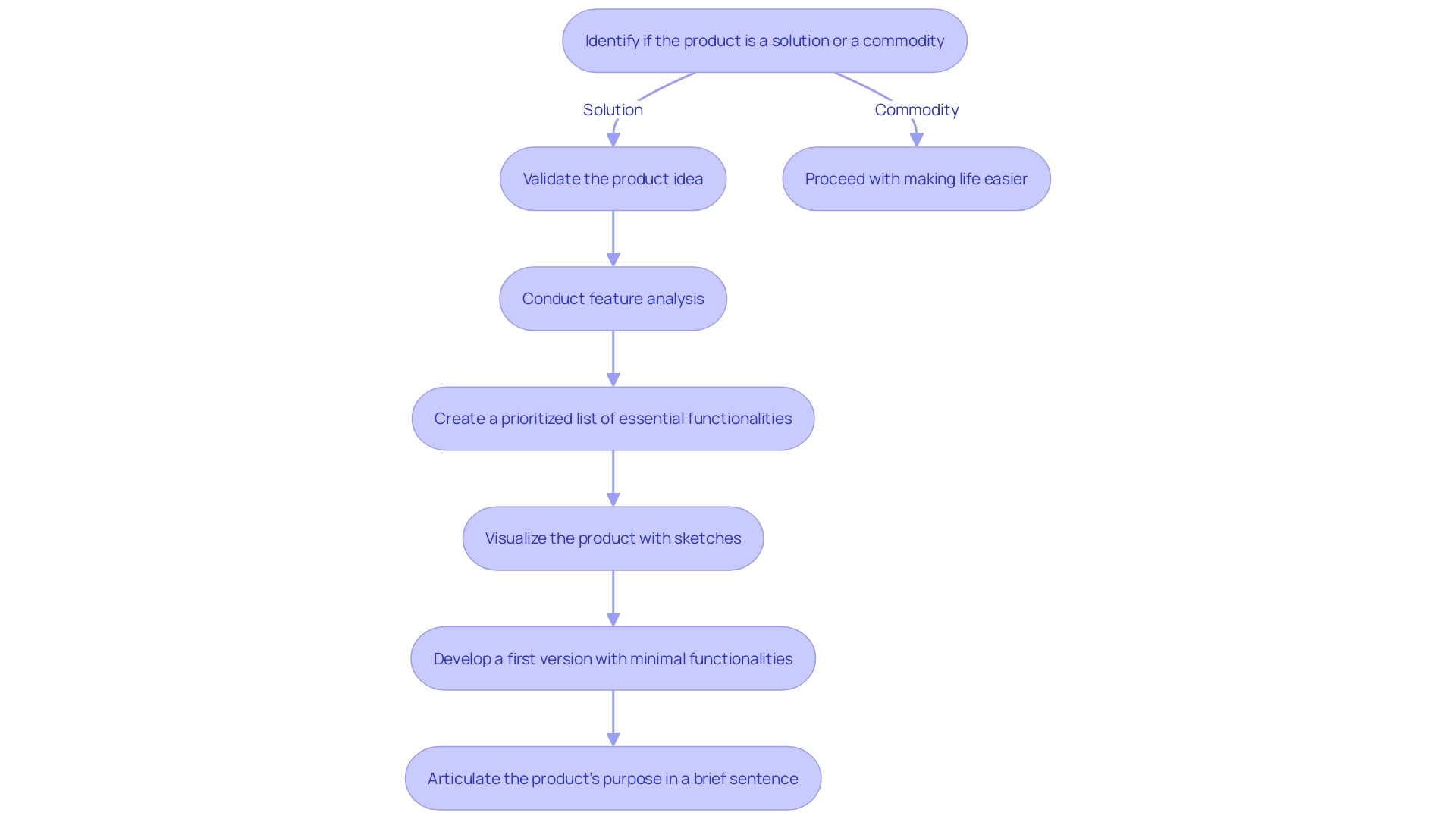
Step 1: Define the Problem and Target Audience
To embark on the journey of MVP development effectively, the initial steps are not to be taken lightly. One must start by identifying the particular issue that the item will tackle. Consider the predicament of a multi-business owner requiring a unified accounting application; this scenario encapsulates the core of a solution-based offering, rather than a mere convenience. Delineating whether your offering is a solution to a critical issue or a value-added commodity is a pivotal distinction. It's a matter of introspection, often clouded by our own biases, yet it is a foundational query that must be addressed with honesty and clarity.
Once the problem is defined, the next stride involves an in-depth understanding of your intended market. Industry statistics indicate a stark reality: 42% of new software-as-a-service (SaaS) products fail due to the absence of a genuine market need. By thoroughly analyzing current market trends, competitor strategies, and gauging unmet customer requirements, you can elevate the likelihood of your MVP resonating with your target audience. Market research is not a one-and-done task; it's both a science and an art that demands continuous attention. Too often, insights are relegated to the archives post-delivery, their deeper implications and values left unexplored. A more strategic approach to revisiting and reanalyzing this data can uncover greater insights, guiding your MVP development with precision.
Visual representation, such as sketches, can be invaluable during the planning phase. Recording your plans, examining each proposed aspect, and curating a list that ranks only the vital functionalities is crucial. After all, the ethos of an MVP is rooted in minimalism—delivering the minimum viable set of features that still provide value. By completing this exercise, you should be able to express the purpose of your offering concisely—a testament to clear vision and focused planning. Remember, the foundation you establish in this early stage can greatly influence the scalability and future achievement of your venture.

Step 2: Identify Core Features
Your MVP should embody the most crucial aspects that cater to the specific requirements of your target audience. Consider the entrepreneur who requires an application to manage the accounting for multiple businesses. This scenario underscores the need for a focused solution rather than a broad commodity. The most valuable player for this circumstance would focus on strong, team accounting capabilities, disregarding unnecessary characteristics that can be incorporated as the offering develops. Reflect on Amazon's origins—selling used college textbooks before expanding its vast inventory. Similar to this, your MVP should begin with a straightforward yet valuable offering, as emphasized by Eric Ries. To identify these characteristics, outline your plans, perform an analysis of the features, and establish a prioritized roster. Visualize your MVP through sketches to clarify the vision. This first iteration should be simple, yet it should clearly convey the product's purpose in a single sentence. An efficiently arranged matrix of characteristics can aid in documenting and tracking the value you deliver to your customers.
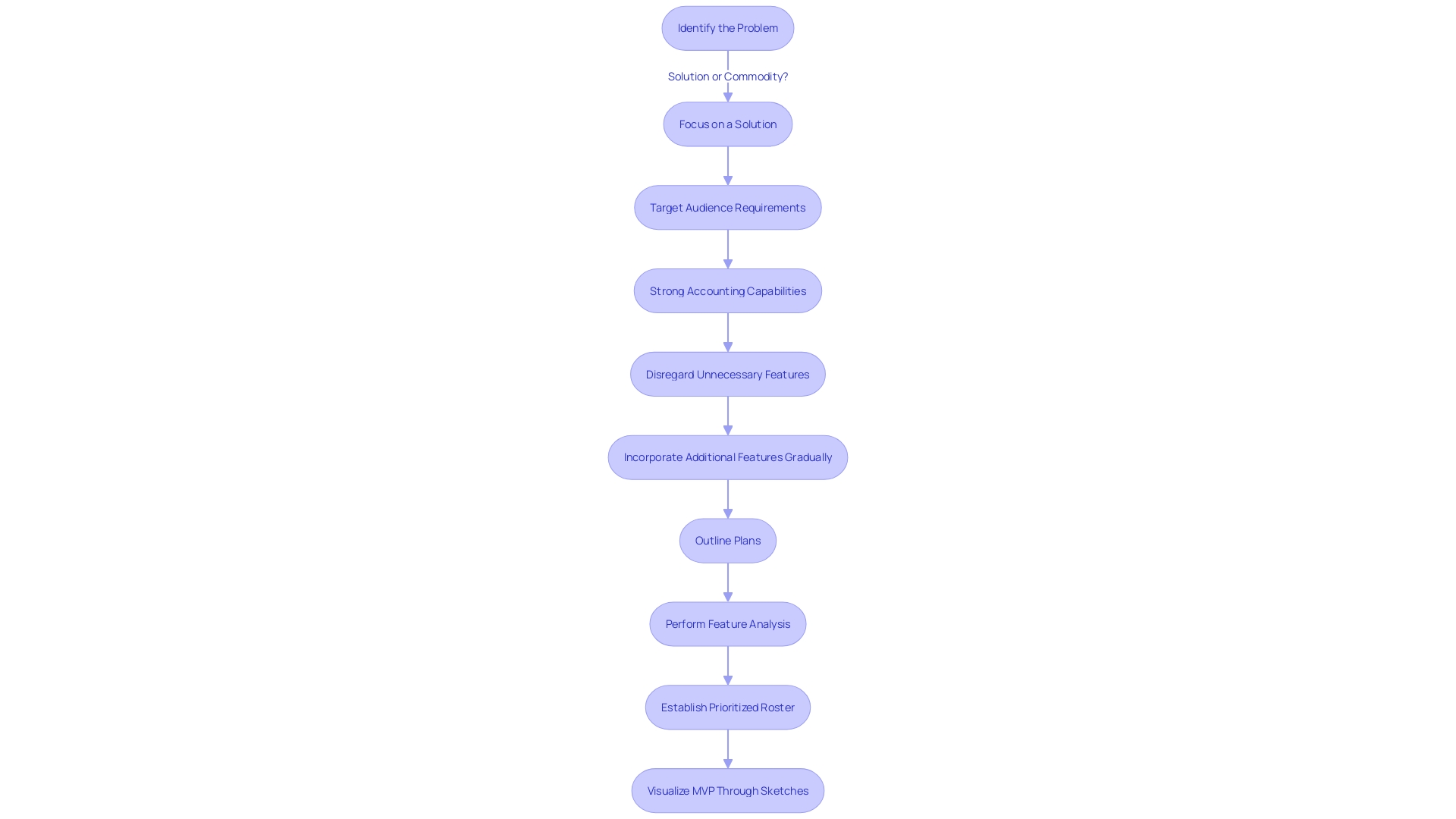
Step 3: Create a Product Requirements Document (PRD)
Crafting a Product Requirements Document (PRD) is a foundational step in the journey of developing a Minimum Viable Product (MVP). This essential artifact functions as a detailed guide for your development team, much like a blueprint, ensuring a shared understanding of the MVP’s scope, features, and functionalities. The PRD is a comprehensive dossier that outlines the stories, cases, and both functional and non-functional requirements. By effectively communicating the intricate details of what the MVP should accomplish, the PRD plays a pivotal role in aligning the development team's efforts with the project’s objectives. It encapsulates the vision for the MVP, ensuring that every team member is not only cognizant of what is to be built but also why it matters, thereby fostering a coherent approach to achieving the project's goals.
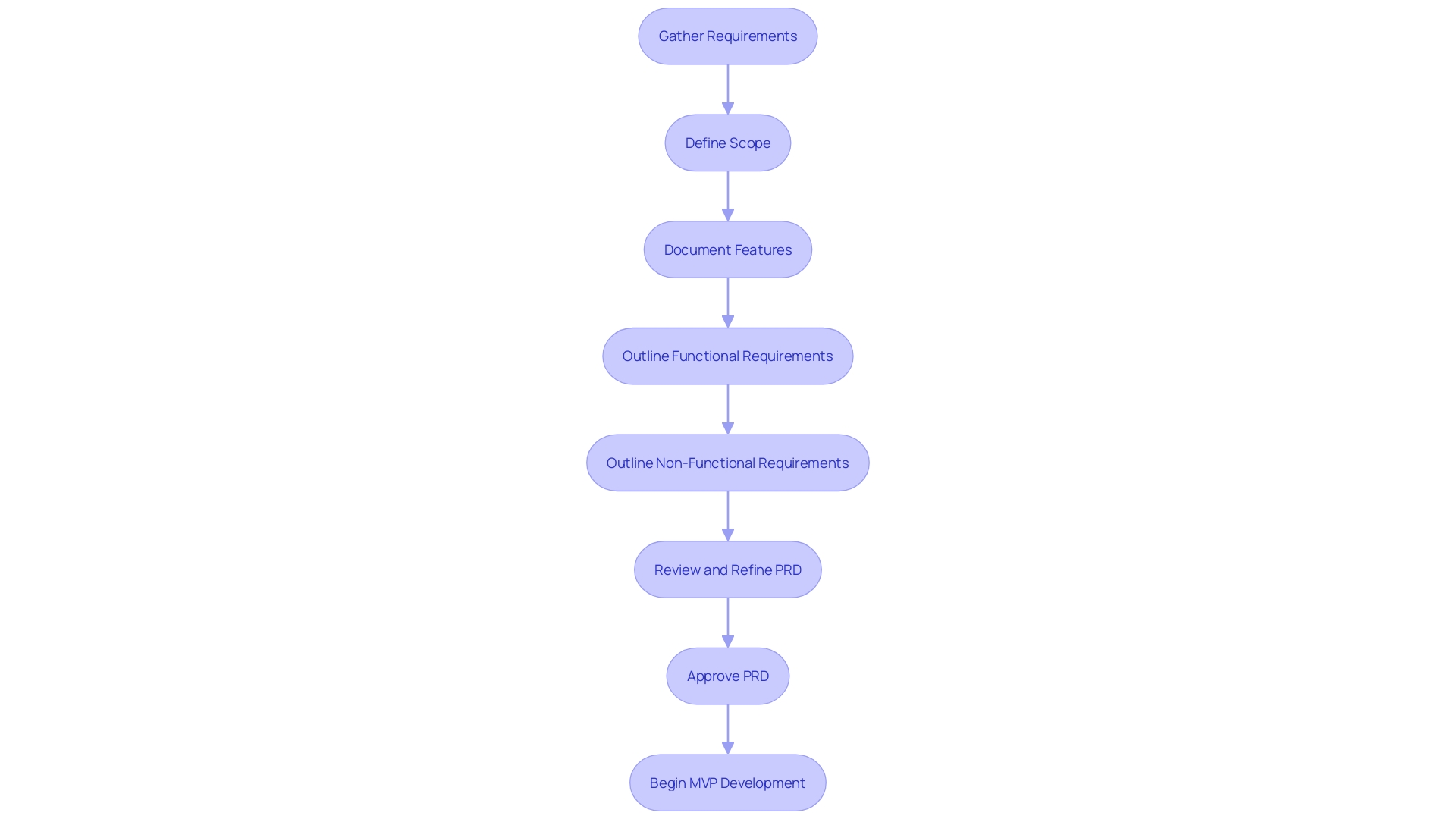
Step 4: Organize Information Architecture
Crafting the information architecture (IA) for a Minimum Viable Product (MVP) is akin to laying the foundation for a building—it must be stable, intuitive, and conducive to future expansion. The IA should clearly define the content, context, and audience, ensuring that each element is thoughtfully placed to serve the intended needs. Inquiries such as the individual's setting, their interaction motives, and the methods they employ to engage with the content are central to this process. By aligning the structure of the MVP with the mental models of individuals, developers can create a product that feels familiar and easy to navigate, even when presenting new concepts or content.
The significance of enhancing the experience (UX), especially on mobile platforms, cannot be overemphasized. Data indicates that more than 50% of all web traffic currently comes from mobile devices, and individuals are uncompromising when it comes to subpar mobile site design. A staggering 50% are unlikely to purchase from brands with subpar mobile experiences. Furthermore, mobile sites that load within two seconds boast a 15% higher conversion rate. It's crucial to create an MVP that not only has an appealing design but also functions perfectly on all devices, giving priority to speed and functionality to satisfy the elevated demands of today's individuals.
By utilizing user-centered research methods, like card sorting, we can reveal how various demographics classify information, which helps with organizing the content and characteristics of the minimum viable product. For instance, in a case study focused on an online platform for selling fruits and vegetables, understanding customer requirements—like the desire for a variety of fresh, organically certified produce—and the necessary application features, such as a comprehensive product catalog and efficient search filters, is crucial. This guarantees that the MVP not only caters to the practical needs of individuals but also aligns with their lifestyle preferences and values.
Ultimately, the MVP's IA should mirror the individual's journey, streamlining their path to achieving their goals. Whether it's navigating to a item description or completing a transaction, every step should be intuitive and accessible. By meticulously crafting an MVP with a friendly IA, developers and designers can significantly enhance engagement and create a product that not only meets the immediate needs but also fosters long-term loyalty.
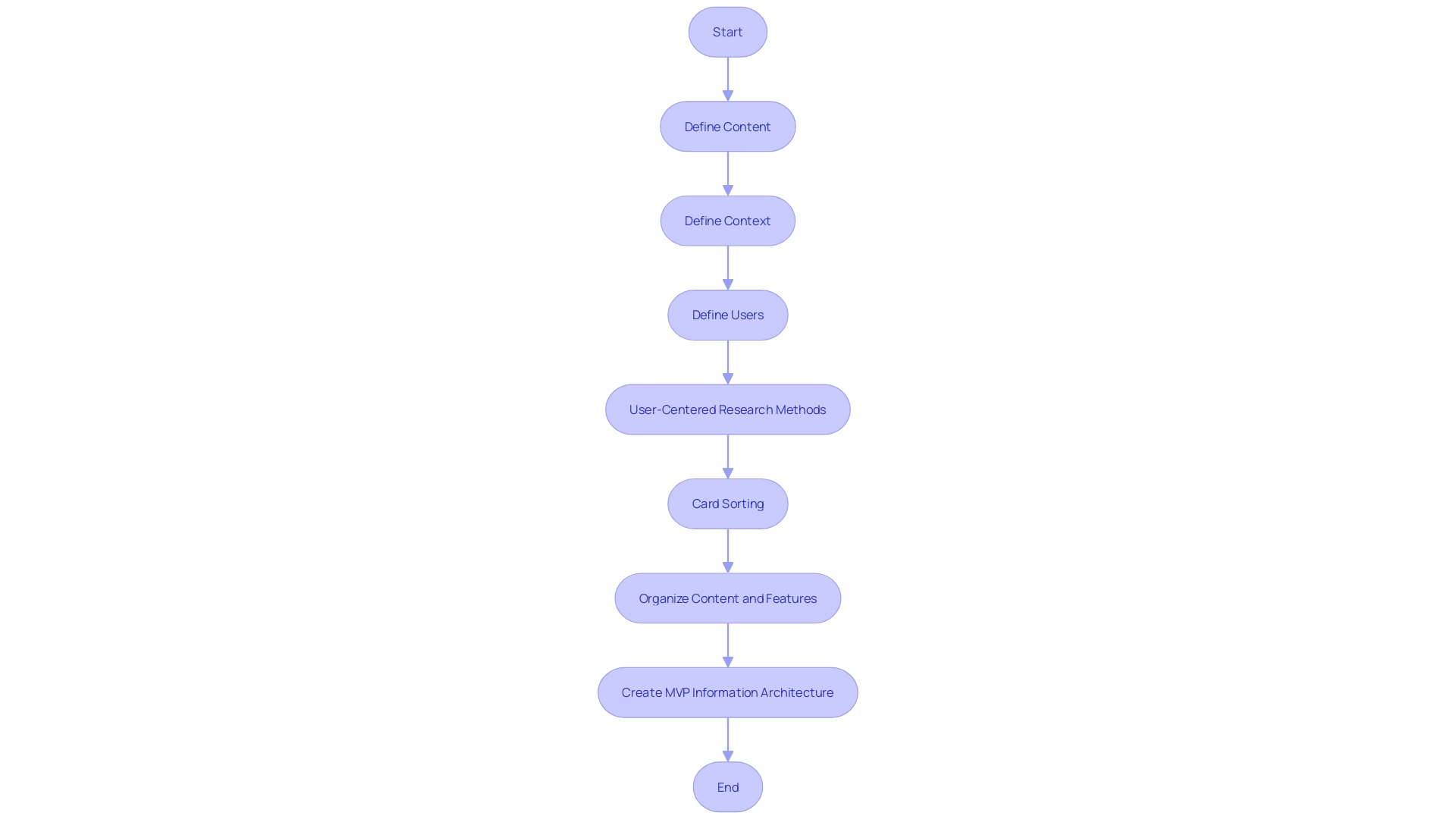
Step 5: Develop a Clear Project Plan
Embarking on the creation of a Minimum Viable Product (MVP) commences with the germination of an innovative idea. This idea is then meticulously refined through an extensive process that includes market analysis, pinpointing the intended demographic, and delineating the fundamental features that will constitute the software. The significance of this phase cannot be overstated, as it ensures the solution not only meets a distinct market need but also stands out in its ability to address specific user problems. Once the concept is crystallized, it is paramount to chart a comprehensive development blueprint. This strategic plan encapsulates the definition of the project's boundaries, the formulation of a timeline that is both pragmatic and aspirational, and the judicious allocation of resources to various tasks.
The process is akin to the methodical approach taken during the construction of monumental structures such as the Hoover Dam, where meticulous planning and delegation of authority to specialists were fundamental to its success. Modern software development similarly necessitates a structured methodology, providing a sequence of carefully orchestrated activities and phases. Development methodologies such as Agile, Scrum, or Kanban, each with their unique principles and advantages, offer a structured path from project inception to completion and define clear roles and responsibilities for team members.
During the planning stage, maintaining a balance between the breadth of the plan and a focus on specificity is crucial to ensure a clear and actionable roadmap for the development team. It is within this framework that the project's quality parameters are established, encompassing functionality, reliability, and usability—each an integral facet of the end outcome's success.
In crafting a project proposal, one must succinctly articulate the objectives, scope, requirements, budget, and deadlines. This document, though not as exhaustive as the project plan, serves as an invaluable reference throughout the project's lifespan, aiding in prioritization and directional decision-making. The creation of a professional project life cycle visualization further enhances the clarity and communicability of these high-level goals.
Ultimately, the software engineering process, as outlined in the Software Engineer Book of Knowledge (SWEBOK), transforms various inputs into high-quality, efficient and cost-effective software systems. By following a methodical, measurable process and utilizing engineering principles, development teams can maneuver through the intricacies of software creation, guaranteeing the release of a solution that aligns with stakeholder expectations and attains the desired effect.
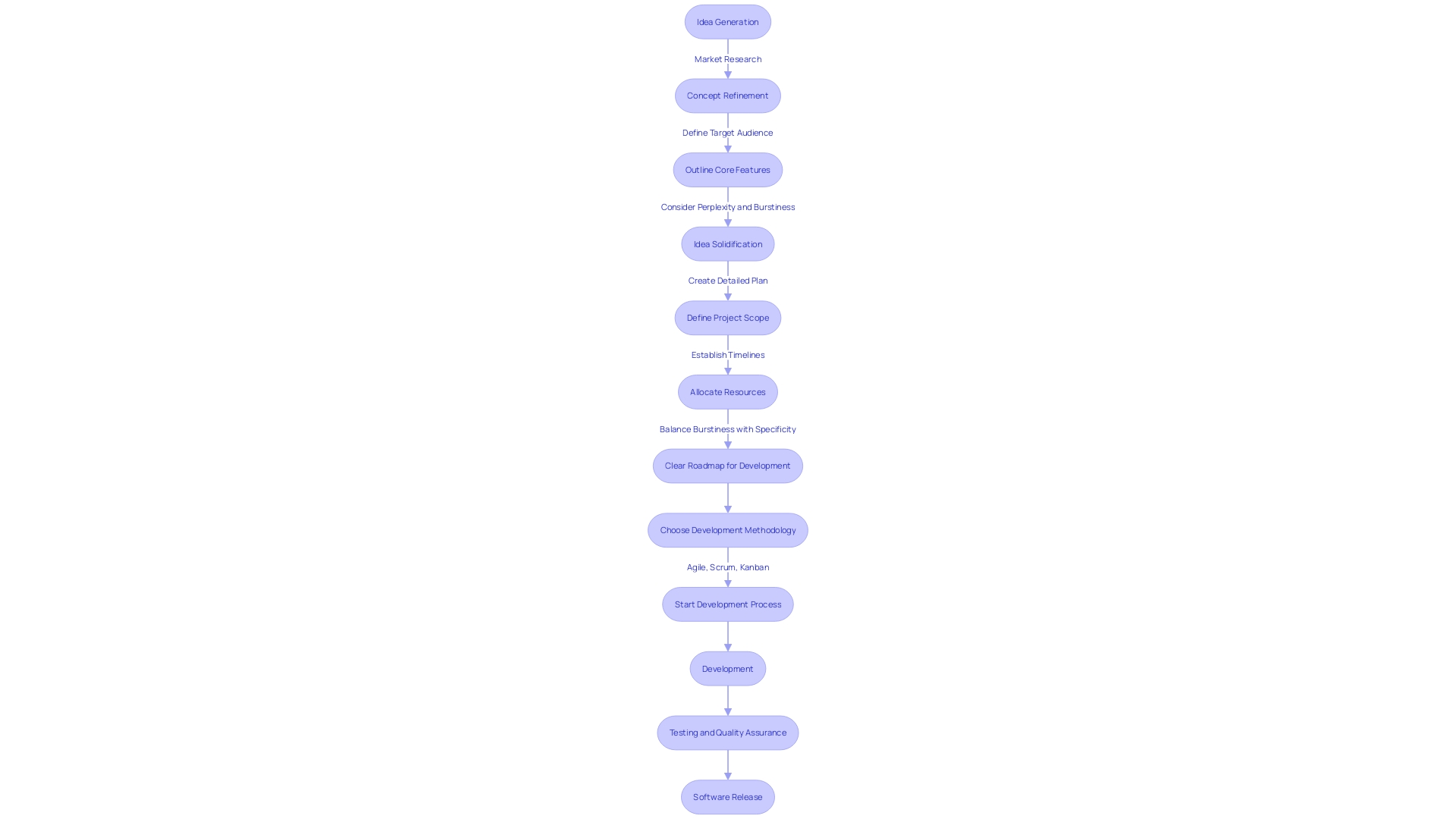
Step 6: Build and Test the MVP
When constructing the MVP, it's critical to embrace agile development practices, which offer a structured yet flexible approach to software creation. This methodology is about breaking down projects into manageable increments, known as sprints, and incorporating regular testing and feedback loops. By focusing on the essential features identified during the planning phase, you can ensure that each component of the MVP not only meets the intended design specifications but also addresses genuine user needs.
Regularly interact with your user base to gather feedback, and utilize this input as a guide to navigate future updates of your offering. This user-centric approach to development and refinement is exemplified by the journey of Amazon, which evolved from a niche online bookstore into a global retail giant by continuously adapting its offerings based on customer behavior and market trends.
Keep in mind that while agile encourages adaptability, it also necessitates a balance with documentation and testing strategies. Even though thorough documentation may change over time, giving priority to testing from the beginning can avoid unnecessary delays and guarantee a more dependable outcome. Moreover, as agile testing is integral to this process, it allows for early detection and resolution of issues, paving the way for a more secure and user-friendly product. This iterative development cycle not only accelerates the time to market but also aligns with contemporary demands for high-quality software amidst growing security concerns.
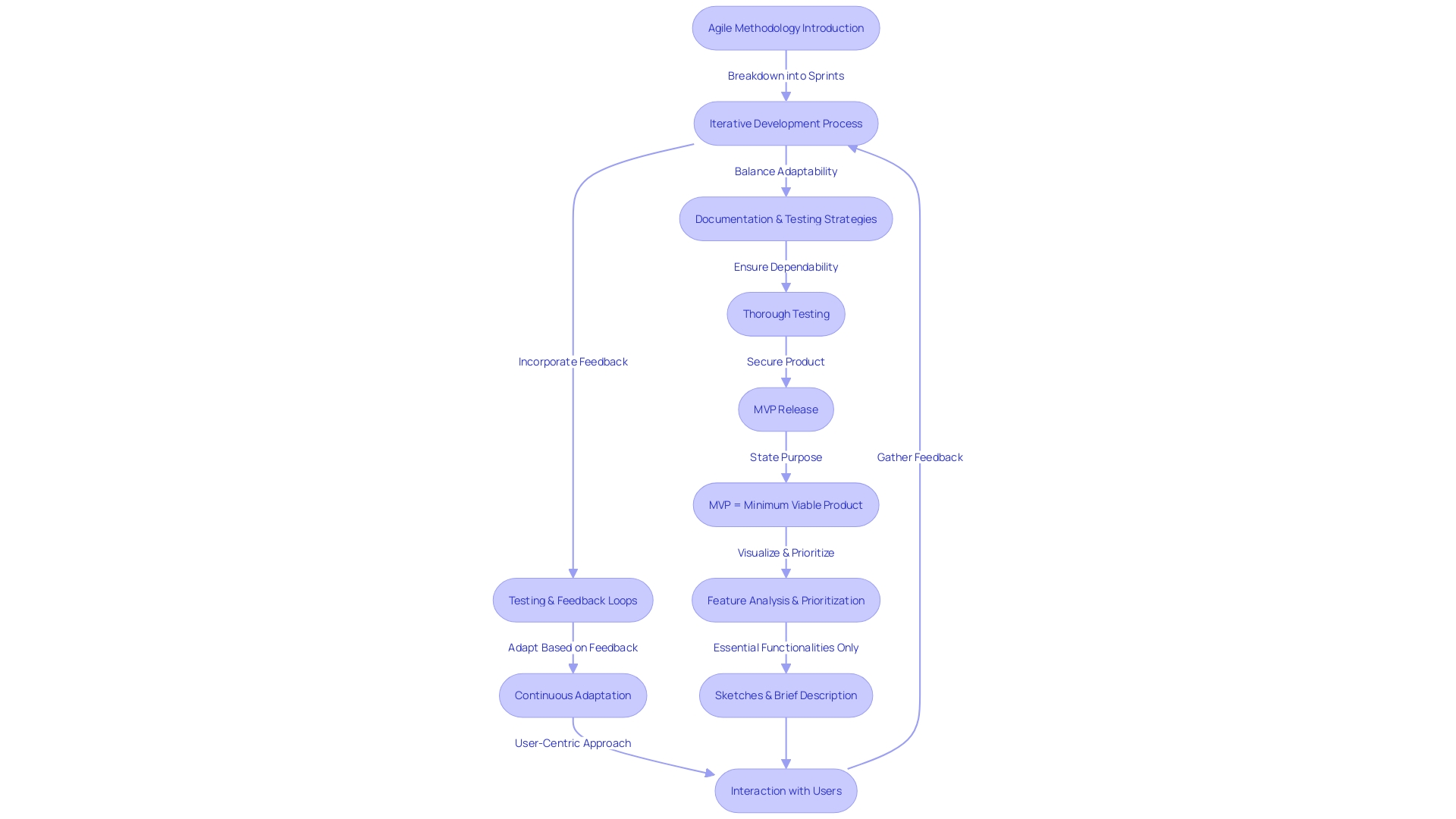
Step 7: Collect and Analyze User Feedback
In the domain of MVP (Minimum Viable Product) development, the opinion of your target audience is priceless. To navigate this terrain effectively, startups should adopt a systematic approach to gathering and interpreting feedback from individuals. Employ a range of tools, such as interviews, analytics, and surveys, to capture the sentiment and experiences of your audience. By exploring the feedback, you can identify important patterns and emphasize the most pressing needs and challenges.
To illustrate, consider an entrepreneur who requires an application to handle the accounting for multiple businesses. In this scenario, the entrepreneur's decision to choose a solution over a commodity is informed by whether the offering solves a specific problem or simply provides convenience. This distinction is pivotal in shaping the MVP's direction.
Utilizing the 'Implementation Investment' approach, as obtained from the Kano model, can enhance the development of your offering. This approach promotes the prioritization of characteristics based on their impact on the individual in relation to the development effort needed for them. Originating from Dr. Noriaki Kano's work in 1984, the Kano model underscores the uneven impact of different product features on customer satisfaction.
Moreover, your MVP should succinctly encapsulate its core purpose in a single sentence, ensuring that only the most essential functionalities are included at launch. A clear, focused vision is essential, as is shown by the fact that more than 50% of individuals may disregard a brand for a poorly designed mobile site. Speed and usability triumph over aesthetics, with mobile sites that load quickly enjoying a 15% higher conversion rate.
In conclusion, by actively searching for and thoroughly examining feedback from individuals, startups can create an MVP that connects with the needs of their audience and distinguishes itself in a competitive market, ultimately improving engagement and satisfaction.
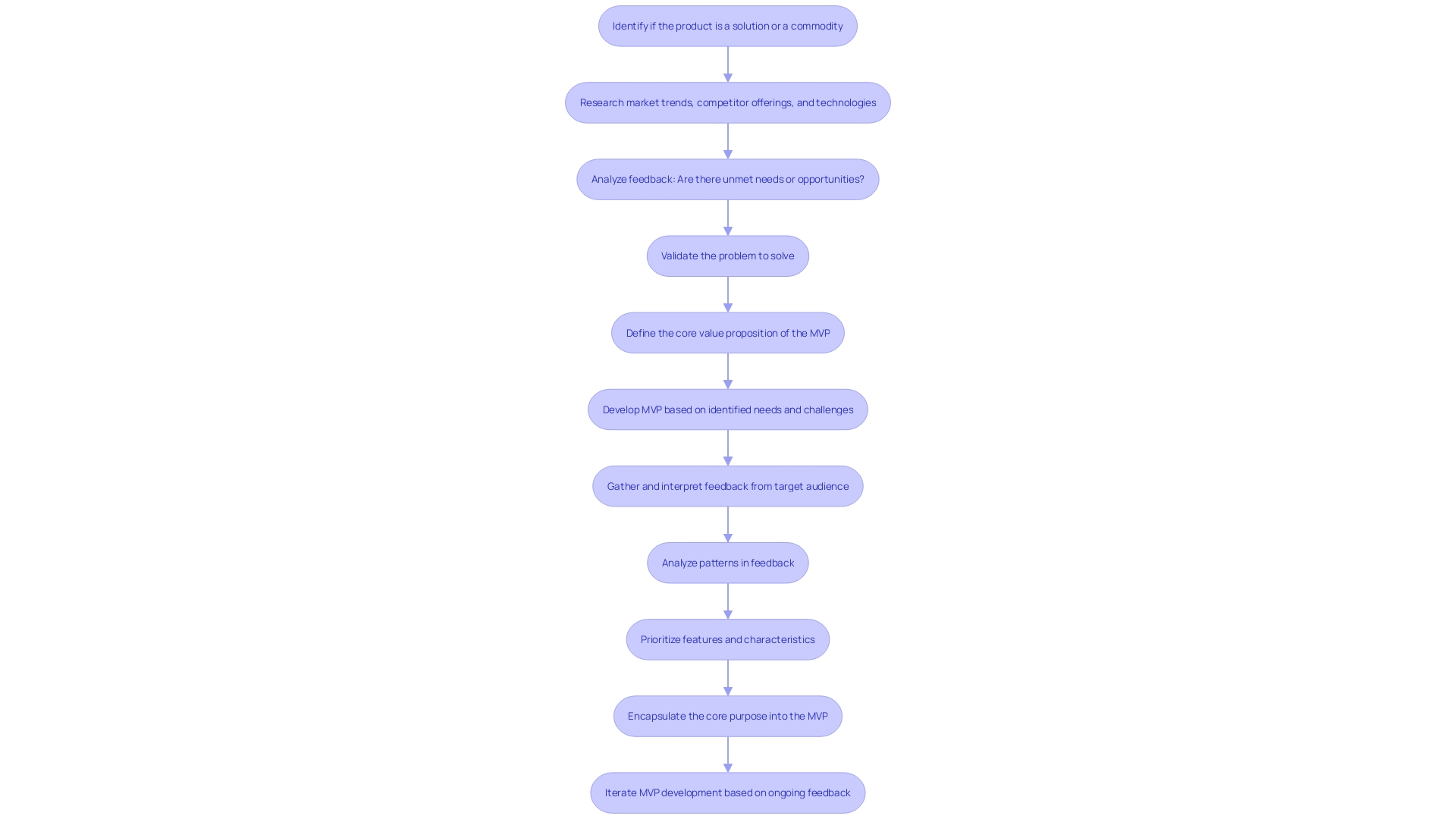
Step 8: Iterate and Improve the MVP
Iterative development is key when refining a product's minimum viable version. The feedback gathered from individuals is a goldmine for understanding how to enhance their experience. By focusing on the most significant improvements, each iteration can hone the MVP, ensuring it better fulfills its purpose with each update. Take, for example, the charity Mind, which, by optimizing their online donation form, significantly boosted their fundraising capabilities. Likewise, in the instance of a hypothetical time-travel app, TimeTrek, the design process, even though centered around an imaginary concept, adhered to real-world practices to craft a captivating experience for individuals. When iterating an MVP, remember Amazon's humble beginnings as a textbook seller and how they incrementally grew to become an e-commerce titan. By addressing the pain points of users and making necessary adjustments, each iteration not only improves the offering but also increases the likelihood of user activation and retention, as evidenced by the statistics: mobile sites that are user-friendly and load quickly have higher conversion rates and user engagement. This approach to MVP development is not just about adding features; it's about crafting experiences that resonate with users and drive them towards the 'aha moment when they realize the value your creation brings to their lives.
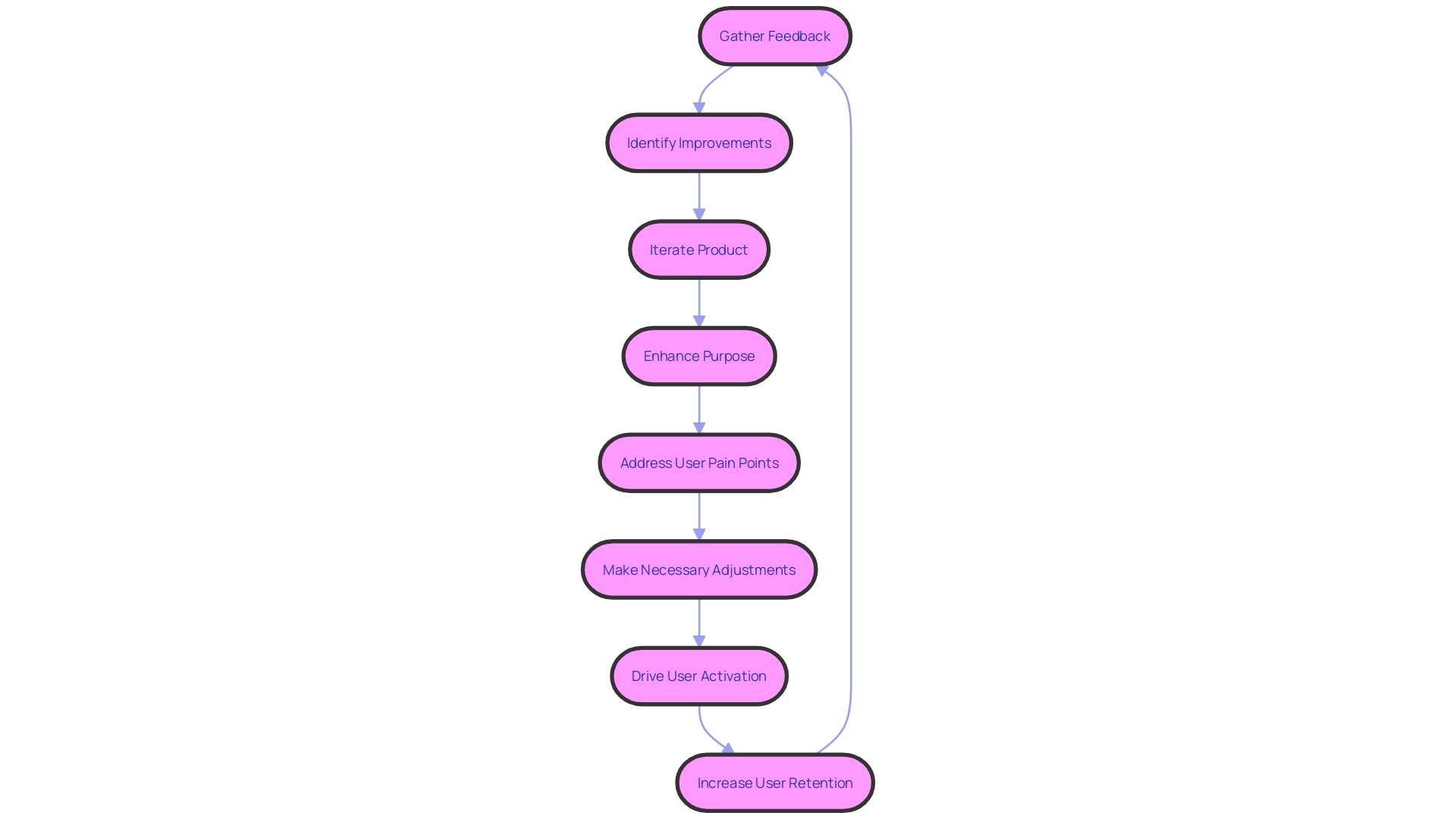
Step 9: Plan for Iteration and Growth
Successful MVP development is akin to laying a solid foundation for a house that's destined to grow. It is not just a starting point for your initial offering; it is the foundation for future improvements and scalability. As the digital marketplace evolves, it's vital to keep a finger on the pulse of industry trends, continuously integrating customer feedback and performance metrics into the development cycle. According to statistics, 42% of new SaaS products fail due to a lack of market need, emphasizing the importance of understanding and validating the problem your MVP aims to solve.
A prioritized roadmap is essential, enabling the smooth integration of new features that cater to the needs and demands of the market. It should be a reflection of a well-thought-out strategy, informed by rigorous market research that highlights user preferences and uncovers untapped opportunities. This strategic approach is backed by Kurt Bittner's expertise, who highlights the importance of delivering solutions in brief, feedback-driven cycles, resulting in offerings that customers genuinely appreciate.
By meticulously planning future releases and prioritizing features, your MVP can evolve into a robust creation that not only meets but anticipates the needs of the market. This foresight is crucial, as the initial architectural decisions lay the blueprint for future scalability. As Pierre Pureur points out, the initial understanding of problems to be solved may be incomplete, but as the feedback loop activates, adjustments can be made to align with the evolving demands of users and the market.
Remember, the journey of MVP development is continuous, with each iteration bringing you closer to a creation that resonates with the market and stands the test of time.
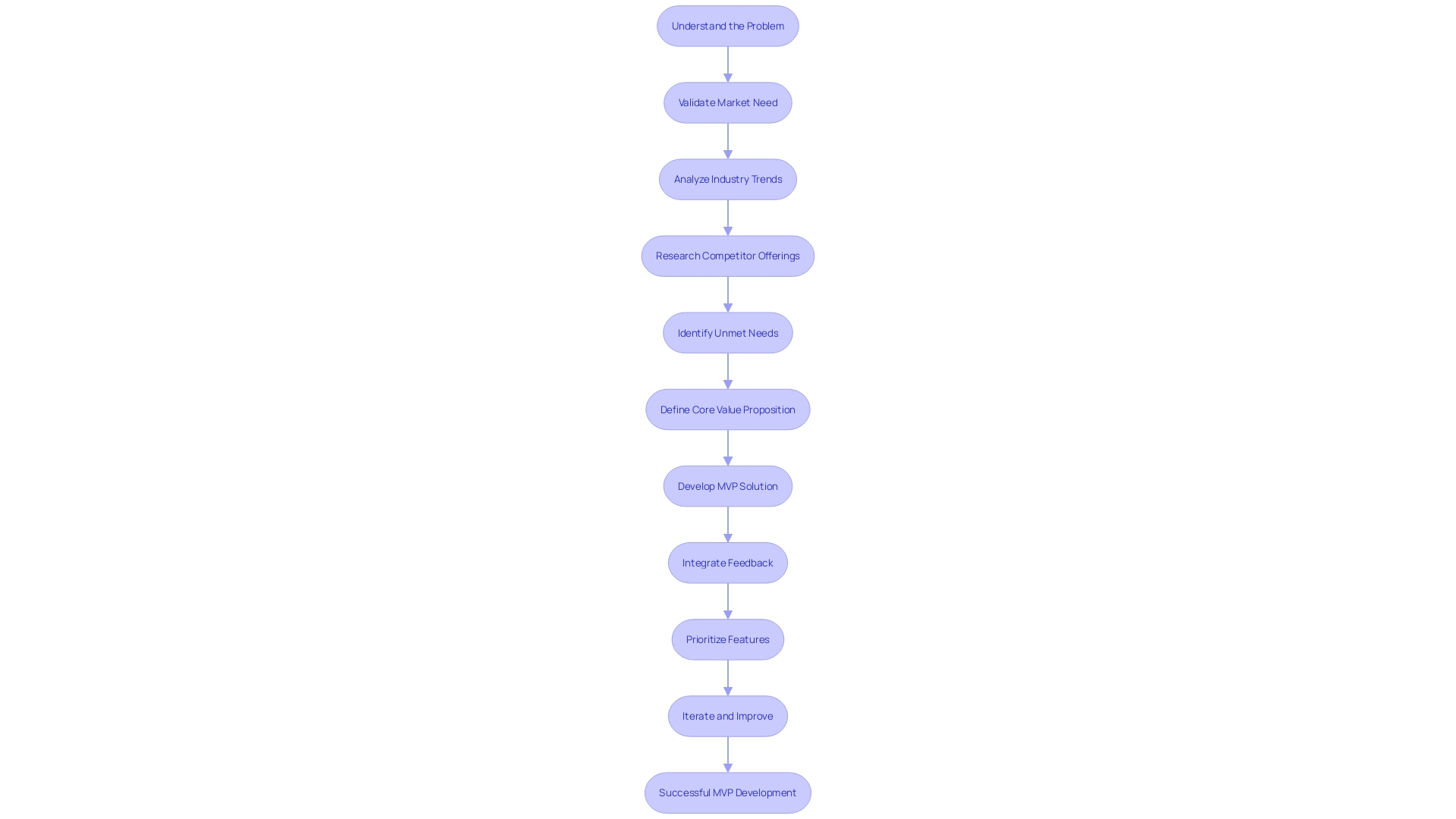
Step 10: Scale Up and Expand the Product
As your MVP begins to gain momentum, validating its market fit and value proposition, the next critical phase is scaling and enrichment. To successfully navigate this growth, your product must evolve. Enhance your features, improve scalability, and elevate the experience—these are the pillars of a flourishing expansion. Marketing strategies must be sharpened and deployed effectively to cast a wider net, engaging an increasingly diverse customer base. The journey of scaling is intricate, demanding meticulous planning and strategic execution, akin to the stories of tech giants like Google, which evolved from a Stanford University project into an internet colossus. Similarly, tapping into the digital evolution, as seen in the largest shopping events like 11.11 and Amazon's Great Indian Festival, can significantly amplify your reach and user acquisition. It's a transformative period that, when managed with foresight and ingenuity, can lead your item down a path of sustained success.
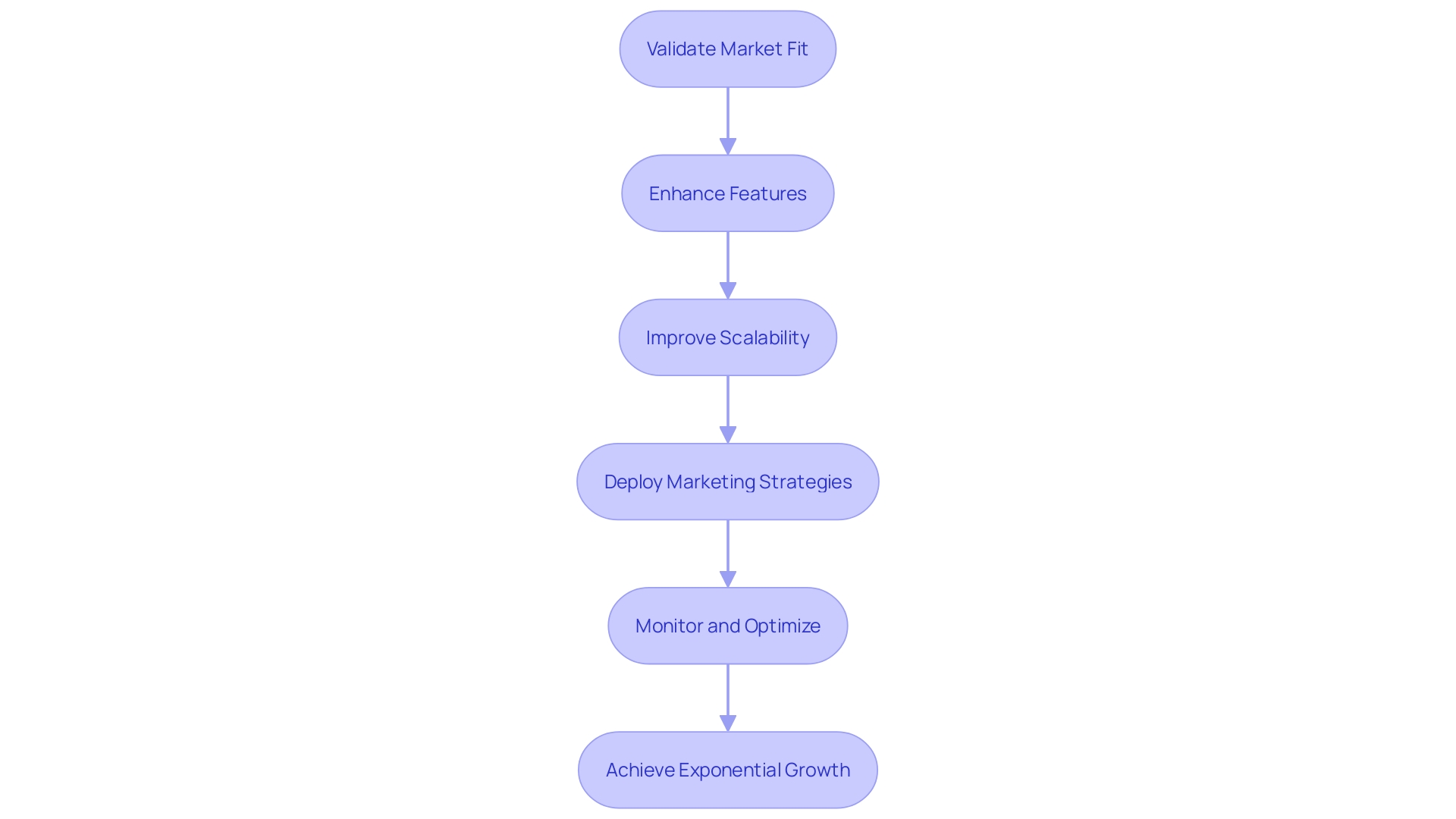
Common MVP Development Pitfalls and Solutions
When embarking on the development of a Minimum Viable Product (MVP), there are several potential pitfalls that could derail your project. To ensure a streamlined process and successful outcome, consider these key strategies:
-
Feature Creep: Overloading an MVP with excessive features can cause delays and complicate the core objective. To address this, establish a characteristics grid to uphold a broad view of your offering's attributes and guarantee consistency with customer requirements. This method aids in preserving attention on crucial aspects that offer tangible benefits to individuals.
-
User Feedback Neglect: User feedback is crucial in refining your MVP. It provides insights that can influence the growth and enhancement of your offering. For example, understanding the 'AHA moment' where individuals first realize the value of your product can guide you in enhancing user experience and tailoring your characteristics to meet actual needs. Engage with your user base and analyze activation metrics to make informed, data-driven decisions.
-
Inadequate Planning: A clear and well-thought-out project plan is indispensable for a smooth MVP development journey. Begin by drafting a feature catalog that outlines the functionalities and prioritize them. Visualize your creation through sketches or notes, and ensure that everyone involved has a comprehensive understanding of the business's system diagram and the specific aspects they need to concentrate on.
Moreover, consider the broader market context by analyzing industry trends, competitor offerings, and emerging technologies. With statistics indicating that 42% of new SaaS offerings fail due to a lack of market need, it's vital to validate the problem you're aiming to solve to increase your chances of success.
In conclusion, by being mindful of these common pitfalls and implementing strategic solutions, developers can effectively navigate through the MVP development process and build a product that truly resonates with the market and their users.
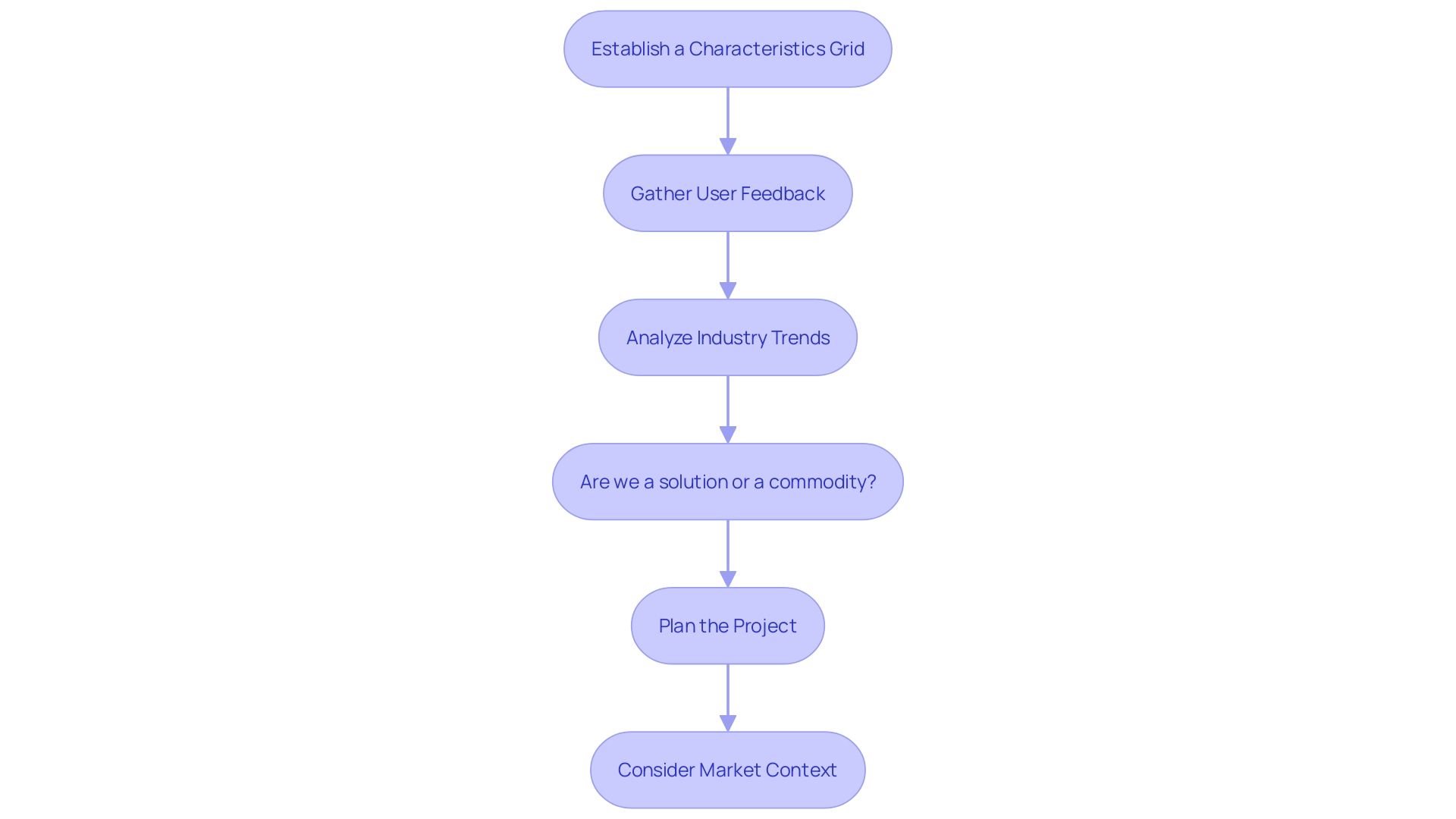
Conclusion
In conclusion, developing a successful Minimum Viable Product (MVP) requires a strategic approach focused on core functionalities, user feedback, and iterative improvement. By accurately defining the problem and target audience, identifying essential features, and creating a clear Product Requirements Document (PRD), developers can lay a solid foundation for their MVP.
Organizing the information architecture and optimizing the user experience are crucial steps in creating an intuitive and user-friendly MVP. By embracing agile development practices, developers can build and test the MVP while incorporating regular feedback loops and user engagement to refine and enhance the product.
Collecting and analyzing user feedback is invaluable for understanding user needs and preferences. By iterating and improving the MVP based on this feedback, developers can create a product that continually evolves to meet user expectations and stands out in the market.
Planning for iteration and growth is essential to ensure the MVP's long-term success. By prioritizing features, integrating customer feedback, and staying informed about market trends, developers can adapt and expand the product to meet changing user needs and stay ahead of the competition.
Scaling up and expanding the product requires enhancing features, improving scalability, and deploying effective marketing strategies. By navigating common pitfalls such as feature creep, neglecting user feedback, and inadequate planning, developers can stay focused and build a successful MVP.
By following these expert recommendations and taking a strategic and iterative approach, developers can effectively navigate the MVP development process and build a product that resonates with the target audience, meets their needs, and stands out in the market. With continuous improvement and a user-centric mindset, the MVP can evolve into a valuable and successful product that drives growth and customer satisfaction.
Contact BestToolbars today to start building your successful MVP and stay ahead of the competition.





